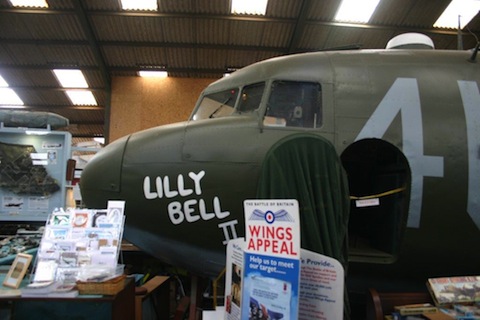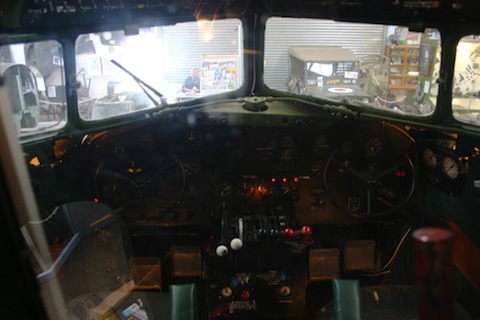 Abraham Lincoln
If given the truth, the people can be depended upon to meet any national crisis...
Abraham Lincoln
If given the truth, the people can be depended upon to meet any national crisis...
 Guildford news...
for Guildford people, brought to you by Guildford reporters - Guildford's own news service
Guildford news...
for Guildford people, brought to you by Guildford reporters - Guildford's own news service
More Details Emerge About Wartime Military Aircraft Crash
Published on: 11 Nov, 2013
Updated on: 12 Nov, 2013
The crash of a US military aircraft at Jacobs Well in October 1944 with the loss of its four-man crew is commemorated with a memorial plaque on the corner of Clay Lane and Queenhythe Road, near the crash site. The plaque and its plinth is recognised as the parish of Worplesdon’s war memorial and a service of remembrance was held there on Monday, November 11.
Since the detailed article by historian and researcher Frank Phillipson published in The Guildford Dragon NEWS in April 2012 about the crash of USAAF C47 transport aircraft “Lilly Bell II” on October 25, 1944 there have some developments with regard to the artefacts recovered from the crash site and newly received records from America.
Frank now takes up the latest details in the story. . .
Approximately 25 miles south-east, as the crows flies, of the Jacobs Well crash site is an aviation museum called the Wings Museum near Balcombe, Sussex. It displays Second World War aircraft and aircraft parts recovered from across Britain and Europe. Many of these are displayed as memorials to the men who flew them.
The centre piece of the museum is a C47 fuselage (which is an amalgam of two different C47’s) painted up as “Lilly Bell II”. It has been used as a film set and appeared in the television series Band of Brothers.
Visitors can go inside the aircraft through the cargo door at the rear and walk up to the front to see its fully equipped cockpit together with radio and navigator’s stations.
It therefore seems appropriate that the small number of items recovered from the crash site be donated to the museum so that they can eventually be displayed alongside the fuselage together with information about the aircraft and its crew.
Further information about “Lilly Bell II” has been found following the receipt of records of the 89th Troop Carrier Squadron for October 1944 and records of the 438th Troop Carrier Group for 1944 from the Air Force Historical Research Agency, Maxwell AFB, Alabama.
“Lilly Bell II” took off at about 10:30am with 13 other C47’s all carrying communications wire to France. At the time of the crash the weather was described as being “extremely bad” and due to the poor visibility the other three aircraft in “Lilly Bell II”s formation did not see the crash take place. It is recorded that the crew were “instantly killed”.
The weather became so bad that all the aircraft were recalled but only two heard the message and returned. The rest carried on to France.
Captain Prindle of the squadron’s medical department visited the scene of the crash at Jacobs Well and talked to the medical officer who had first seen the bodies. It seems that Prindle visited the Connaught Military Hospital (part of Brookwood Hospital) at Knaphill where the bodies had been taken as the record then mistakenly goes on to identify Knaphill as the crash site.
Much emphasis is placed on the fact that only Dellinger’s body was easily identifiable because he was the only one wearing his dog tags. The others had to be identified from belongings on the bodies. A recommendation was made that dog tags must be worn “AT ALL TIMES”.

89th TCS Medical Section report on the crash of Lilly Bell II. It states that the crash was at Knaphill.
It would seem that the squadron engineering department recovered the wreckage of “Lilly Bell II” from the crash site as it is only in their documents that an accurate record of the crash site location is made “one and a half miles north of Guildford”.
The squadron’s technical supply department received the tools recovered from the wreckage but noted that “most of the tools are unserviceable due to the terrific impact of the crash”.
On Tuesday October 31, 1944, a C47 from the squadron took off from its airfield at Greenham Common carrying the closest friends of the deceased to the funeral near Cambridge at the American Military Cemetery. All the crew (1st Lt. Avent, Flight Officer Wright and Technical Sergeant Hillmer) were buried that day with the exception of Staff Sergeant Dellinger, who having been identified more quickly, had been buried earlier on Saturday, October 28, 1944, unbeknown to the squadron.
Investigation is now being undertaken to try to identify the regular co-pilot of “Lilly Bell II”. The co-pilot on the day of the crash was Flight Officer John Wright who was a glider pilot being given extra flying time.
At 11am on Monday, November 11, 2013, Remembrance Day was commemorated by Worplesdon Parish Council, Jacobs Well Residents’ Association, and local residents at the “Lilly Bell II” memorial with two minutes’ silence, laments played by piper Kenneth Thompson, and the laying of a wreath for the crew of the aircraft and all those who lost their lives in war. See separate story.
Responses to More Details Emerge About Wartime Military Aircraft Crash
Leave a Comment Cancel replyPlease see our comments policy. All comments are moderated and may take time to appear.
Recent Articles
- Guildford Institute’s Crowdfunding Project for Accessible Toilet in its New Community and Wellbeing Centre
- Letter: Guildford – Another Opportunity Missed?
- Letter: GBC’s Corporate Strategy – Where Is the Ambition?
- My Memories of John Mayall at a Ground-breaking Gig in Guildford Nearly Six Decades Ago
- Westborough HMO Plans ‘Losing the Heart of the Street’ Says Resident
- College Invests to Boost Surrey’s Economy and Close Digital Skills Gap
- Community Lottery Brings Big Wins for Local Charities
- GBC Housing Plan Promises ‘A Vibrant Urban Neighbourhood’ Near Town Centre
- Hospital Pillows ‘Shortage’ at the Royal Surrey
- Updated: Caravans Set Up Camp at Ash Manor School


Recent Comments
- Ian Macpherson on Updated: Main Guildford to Godalming Road Closed Until August 1
- Sara Tokunaga on GBC Housing Plan Promises ‘A Vibrant Urban Neighbourhood’ Near Town Centre
- Michael Courtnage on Daily Mail Online Reports Guildford Has Highest-paid Council Officer
- Alan Judge on GBC Housing Plan Promises ‘A Vibrant Urban Neighbourhood’ Near Town Centre
- John Perkins on GBC Housing Plan Promises ‘A Vibrant Urban Neighbourhood’ Near Town Centre
- S Collins on GBC Housing Plan Promises ‘A Vibrant Urban Neighbourhood’ Near Town Centre
Search in Site
Media Gallery
Dragon Interview: Local Artist Leaves Her Mark At One of England’s Most Historic Buildings
January 21, 2023 / No Comment / Read MoreDragon Interview: Lib Dem Planning Chair: ‘Current Policy Doesn’t Work for Local People’
January 19, 2023 / No Comment / Read MoreA3 Tunnel in Guildford ‘Necessary’ for New Homes, Says Guildford’s MP
January 10, 2023 / No Comment / Read More‘Madness’ for London Road Scheme to Go Ahead Against ‘Huge Opposition’, Says SCC Leader
January 6, 2023 / No Comment / Read MoreCouncillor’s Son Starts Campaign for More Consultation on North Street Plan
December 30, 2022 / No Comment / Read MoreCounty Council Climbs Down Over London Road Works – Further ‘Engagement’ Period Announced
December 14, 2022 / No Comment / Read MoreDragon Interview: GBC Reaction to the Government’s Expected Decision to Relax Housing Targets
December 7, 2022 / No Comment / Read MoreHow Can Our Town Centre Businesses Recover? Watch the Shop Front Debate
May 18, 2020 / No Comment / Read More













Peter Logan
December 2, 2014 at 8:53 pm
I wonder could a Willys Jeep trailer have been part of the Lilly Bell II cargo?
The reason I ask this is because recently I discovered a rusty old trailer in the grounds of the Shooting Lodge, which is just up the road from the crash site.
The trailer was destined for the scrap yard but I saved it as I recognised it as a Willys jeep trailer. It has now been restored to its wartime original condition and is in the hands of a local Willys Jeep collector.
Frank Phillipson
December 7, 2014 at 11:24 pm
Peter,
I do not think that there was a trailer on board. The official documents state that the whole load consisted of “signal equipment” comprising “coils of field wire”. I think that any trailer carried would have been mentioned.
If one had been on board I don’t think it would have survived the severe impact and intense fire that then occurred. We found molten portions of aluminium when the crash site was investigated.
Frank Phillipson.